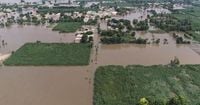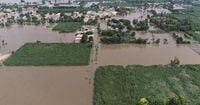As the monsoon season barrels through South Asia in 2025, communities across India and Pakistan are grappling with some of the worst flooding in decades. Rivers have burst their banks, villages are underwater, and millions of lives have been upended by relentless rain and surging floodwaters. The scale of the disaster is staggering, with both human tragedy and economic loss mounting by the day.
In India’s Punjab state, the government declared the entire region disaster-hit as rising waters inundated all 23 districts, submerging over 1,400 villages and affecting approximately 350,000 people, according to The Logical Indian. The devastation is widespread: more than 148,000 hectares of standing crops, primarily paddy fields just weeks from harvest, have been destroyed. The loss of crops and livestock has hit rural livelihoods hard, further compounding the humanitarian crisis. Punjab’s Chief Minister Bhagwant Mann and Governor Gulab Chand Kataria are actively monitoring the situation and have urgently requested ₹60,000 crore in pending disaster relief funds from the central government to bolster rescue and recovery efforts.
The situation on the ground is dire. Emergency rescue operations have evacuated nearly 20,000 people, with the National Disaster Response Force (NDRF), Indian Army, Air Force, and local authorities working around the clock. A total of 23 NDRF teams, 12 army columns, engineer units, and about 35 helicopters have been deployed to rescue stranded residents and deliver aid. The Bhakra and Pong dams are reportedly at near-dangerous water levels, exacerbating downstream flooding. Essential services have been disrupted, with telecom and power departments scrambling to maintain operations amid the chaos.
The human toll is painfully evident. At least 30 people have died in Punjab, India, with the swollen Ravi river alone causing six deaths in Pathankot district, The Logical Indian reported. The crisis has forced authorities to close schools, colleges, and other educational institutions until September 7, 2025, to ensure public safety. The August rainfall in Punjab was a staggering 74 percent above normal—the highest in 25 years—according to state officials. Persistent rainfall forecasts and continued flood alerts mean the danger is far from over.
Further east, the capital city of Delhi and its surrounding National Capital Region (NCR) have also been battered by continuous heavy rains. The Yamuna River surged above its danger mark late on September 2, 2025, reaching 207 meters and forcing the evacuation of nearly 10,000 people living along its banks, as confirmed by The Independent. Main roads in Delhi, including Mathura Road, Vasundhara Gate, and Vasudev Ghat, have been submerged, with rescue teams using boats and relief vehicles to evacuate residents from the worst-hit areas. The Central Water Commission confirmed the river breached its danger level, and authorities shut down schools while urging residents to stay indoors.
“The situation is serious in areas like Mathura Road, Vasundhara Gate, and Vasudev Ghat,” authorities noted, highlighting the urgency of ongoing rescue efforts. The Indian Meteorological Department (IMD) has issued heavy to very heavy rain alerts for many states, warning that worsening weather could further complicate relief operations. In Himachal Pradesh, all schools and colleges were closed until September 7 due to heavy rains and the risk of landslides, adding to the region’s woes.
The deluge has not spared Pakistan either. In Punjab province, nearly 300,000 people were evacuated in just 48 hours as of September 3, 2025, following flood alerts issued by India via diplomatic channels, according to the Associated Press. In total, about 1.3 million people have been displaced since late August, marking one of the largest rescue and relief operations in the history of Punjab, which straddles eastern Pakistan and northwestern India. Floodwaters have submerged dozens of villages in Muzaffargarh, Narowal, and Sialkot districts, and more than 3.3 million people across 33,000 villages have been affected.
Arfan Ali Kathia, director-general of Punjab’s Provincial Disaster Management Authority, described the scale of the effort: “Thousands of rescuers using boats are taking part in the relief and rescue operations, while the military has also been deployed to transport people and animals from inundated villages.” Drones have been employed to locate stranded residents, and about 40,000 people are currently in relief camps. Yet, many survivors have complained about a lack of government aid. Noor Mohammad, a 54-year-old farmer from Sher Shah village, said, “Frustrated over this days-long situation, I sent my family members to stay with relatives in the nearby area.” Malik Ramzan, another displaced resident, added, “There are no liveable facilities in the camps. Food isn’t delivered on time, and we are treated like beggars.”
Punjab Chief Minister Maryam Nawaz Sharif visited flood-hit Muzaffargarh on September 3, 2025, meeting with displaced families at relief camps and promising compensation for those who lost homes and crops. The flooding also submerged the shrine of Guru Nanak near the Indian border, but authorities have since reopened the site to pilgrims after cleaning and restoration efforts.
The crisis is not confined to Punjab and Delhi. Across North India, at least 130 people died in August 2025 due to harsh monsoon rains, with fresh landslides in Jammu and Himachal Pradesh killing at least five more on September 3, as reported by The Independent. The Chenab and Tawi rivers burst their banks, cutting off roads and power supplies in mountain regions and hitting tourist hubs with repeated landslides. In Pakistan, the National Disaster Management Authority reported at least 881 deaths nationwide since the start of the 2025 monsoon season, making it the country’s worst flooding since 2022, when nearly 1,700 people died in climate-induced deluges.
Both countries are facing mounting criticism over disaster preparedness and response. In India, debates have intensified about environmental management, climate change, and the role of human activity in exacerbating natural calamities. Experts are calling for better long-term planning and more sustainable practices to mitigate future disasters. The Logical Indian emphasized, “This tragedy urges society to cultivate a shared sense of responsibility towards climate stewardship while prioritising dialogue and kindness in disaster responses.”
For many, the floods have laid bare the vulnerabilities of infrastructure and governance. Delays in aid, challenges in accessing resources, and the sheer scale of the crisis have tested the resilience of affected communities. Yet, the response has also showcased the dedication of rescue workers, the solidarity of neighbors, and the urgent need for both immediate relief and long-term change.
As the rains continue and rivers remain swollen, the people of India and Pakistan brace for more uncertainty. Their stories—of loss, courage, and hope—underscore not just the destructive power of nature, but also the enduring spirit of those determined to rebuild their lives, one day at a time.


